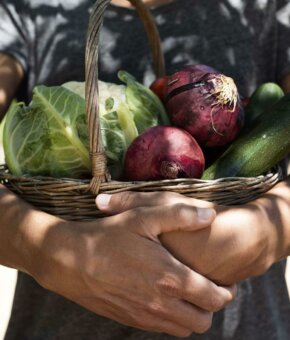
Our food system is an important driver of climate change. The unsustainable way our food is currently being grown, distributed and consumed contributes massively to global warming and biodiversity loss. But food can also be a solution to climate change and enable cities to become more climate resilient.
In Project Drawdown, the hundred most scalable, doable and economically viable solutions to climate change have been gathered. Eight of the top twenty solutions are related to food. In fact, the number one solution to climate change according to Project Drawdown is reducing food waste. By wasting less, we have to produce less, which means less (unnecessary) stress on our natural world. Production of local, healthy and fresh food enables us to close the gap between farm and fork and to reduce losses throughout the chain.
Besides the direct contribution of a sustainable, local food system to the reduction of greenhouse gas emissions, growing our food inside urban areas has a number of additional benefits to help cities adapt to the effects of climate change.
Our food can cool down the city
Concrete buildings, roads, and other urban infrastructure absorb and re-emit the sun’s heat more than natural landscapes such as forests. That’s why urbanized areas often experience higher temperatures than surrounding areas. And as our cities grow and our planet is warming up, these heat islands are becoming a growing threat to the liveability of our urban areas.
Increasing the number of trees and vegetation can significantly reduce the temperature of a city. In city parks, on a hot day, the temperature can be up to five percent lower than in concrete city centers and increasing green coverage by ten percent can lower the heat island effect with as much as 0,6 ºC.
Urban food forests and rooftop farms combine the best of both worlds: they help to lower the temperature and provide urban dwellers with fresh, nutritious food.
Vegetables against flooding
Climate change is making our cities more vulnerable to extreme weather events, including storms and floods. Sustainable urban agriculture enables cities to better cope with high intensity rainfalls. In Taipei, where urban farming has been promoted since 2015, studies show that urban farms and green rooftops work as a sponge. They increase water retention and reduce the volume of surface runoff.
The Green Belt Project in Rosario, Argentina, is another inspiring example of how cities use urban agriculture as a method to adapt to erratic rainfall. By permanently designating 800 hectares of peri-urban land to be used for agroecological fruit and vegetable production, flood risks of the nearby river are reduced.
Beans on bikes
Our food travels all over the world. And although some regions are simply better fit to grow certain crops, it’s no exception to see apples in the aisles of supermarkets that have been imported from the other side of the world in a country where apples grow abundantly. A shift towards a food system where we eat what is grown close(r) to home, reduces the number of unnecessary kilometers our food bridges in order to reach our plates.
All over the world, initiatives are sprouting that show we don’t need to burn fossil fuels in order to transport our food. Cargonomia in Budapest locally produces food and transports it by bike to consumers. Urban food forests allow urban dwellers to pick their food while walking. Supermarkets are building greenhouses on top of their stores to directly provide customers with fresh food. And initiatives such as the Million Gardens Movement inspire people to simply step outside their homes and grow food in their front or backyard.
Make urban agriculture an integral part of climate strategy
A growing number of cities are seeing the potential urban agriculture has as a pillar for their climate strategy. Cities like Rosario (Argentina) and Toronto (Canada) already have an active strategy to boost food production within their city boundaries and are showing how this can be done. Urban planners, real estate developers, architects and government officials play an important role in implementing solutions that make cities more climate resilient. If you are working in one of these areas and you are inspired to take action, here’s a few things you can do.
Are you inspired by this story? Make sure to sign up for our monthly newsletter and get the best stories about sustainable urban food production delivered straight to your inbox.



